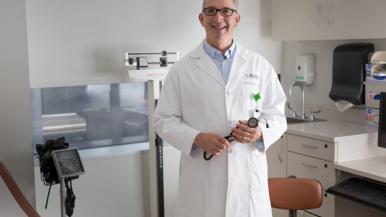A Lifelong Path Toward Health Equity
David Ansell keeps a picture of his great-grandfather on his computer. In the picture, Moishe Moses is wearing a yellow star arm band and is standing in front of tombstones in a Jewish cemetery in Poland, forced to pose by a Nazi soldier. He was murdered the next year. When the soldier died in 2006, the photo eventually was discovered and returned to Moses’ survivors. If Ansell’s grandparents hadn’t escaped Poland in the early 1900s, the only ones in their families to leave before the Nazis came to power, it’s not certain David Ansell would be alive today.
“Early in life, I had a sense that incredible injustice existed in the world. I grew up in the aftermath of the Holocaust wondering how it happened and asking why people didn’t speak up,” says Ansell, senior vice president for community health equity at Rush University Medical Center, who also is associate provost for community affairs and the Michael E. Kelly, MD, Presidential Professor of Rush University. “When I became a doctor, and first encountered deep health inequities, I knew that I needed to give voice and my attention to marginalized populations living in poverty and experiencing structural racism. It took me many, many years to understand that medical care by itself was not enough. ”
As a doctor for 27 years at what is now John H. Stroger, Jr. Hospital of Cook County and the Sinai Health System, Ansell saw firsthand how a person’s circumstances affect their health. In addition to genetics and lifestyle, where patients live and factors such as poverty, racism and other forms of exclusion has a tremendous impact on their likelihood of developing chronic disease and dying prematurely.
For example, the average life expectancy for a resident in Chicago’s Loop is 85. But just a few miles away in West Garfield Park, average life expectancy plummets to 69 — similar to the national average in the late 1950s and early 1960s, according to U.S. Census data.
“It wasn’t just that people didn’t eat enough broccoli,” Ansell says. “Where you live dictates when you die, especially if you’re poor and a minority. If we’re going to improve health, which is our mission, then we have to turn our attention to the neighborhood conditions that influence health and do what we can to improve them.”
A supportive community at Rush
Ansell found the support he needed to begin addressing health inequities when he came to Rush University Medical Center in 2005. Rush has long demonstrated a willingness to serve Chicago’s West Side communities and other people facing various social and economic disadvantages. But moving the needle on these challenges requires additional intentionality and support. In 2016, Rush made health equity a strategic priority.
During its 2017 fiscal year, Rush crafted its Anchor Mission strategy: a plan to align internal resources to improve health in nine West Side neighborhoods that are home to nearly 500,000 people. Instead of just treating the illnesses that arise from inequities, Rush is working to create healthier communities — in part by making sure that its economic power helps to boost the economic vitality of neighborhoods where poverty is concentrated.
“People at Rush understand that we can affect change not just within our walls but outside in our communities, and they are eager to do so,” he says.
Improving health outside of the Medical Center
Rush maintains a wide spectrum of staff-, faculty- and student-led community programs aimed at addressing social determinants of health — factors including poverty, educational attainment, employment, lack of safe housing and food security. Rush’s efforts to remove these barriers to health include creating educational pathways to health care careers, expanding health screenings in neighboring communities, leading school-based health clinics, building wealth among low-wage employees, fostering volunteer community engagement and support, and promoting diversity and inclusion at all employment levels at Rush.
On May 10th, Ansell served as the honorary chair for the 12th Annual Rush Associates Board Casino Night in support of these programs, improving health equity and moving Rush closer to its goal of cutting the life expectancy gap on the West Side in half by 2030.
“Our leadership and staff can see that seemingly intractable problems can be solved,” Ansell says. “To have the whole organization aligned around this, it makes people want to join us. It encourages students want to study here.
“I went into medicine because I wanted to change the world, and our health equity strategy allows our employees and students to Rush to do just that.”
Learn more about the Rush Associates Board Casino Night online. Please contact Jaclyn Groves, associate director of auxiliary groups, with questions at (312) 942-6874 and jaclyn_groves@rush.edu.




